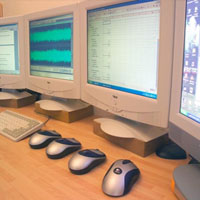Pan-European supercomputer comes a step closer to reality
European researchers will soon have access to a world-class high performance computing infrastructure, thanks to the new 'Partnership for Advanced Computing in Europe' (PACE) initiative. PACE brings together the supercomputing centres of 15 European countries, with the goal of strengthening European science, engineering and supercomputer technologies. At a ceremony in Berlin on 17 April, the partners signed a Memorandum of Understanding for the new initiative. 'I am very pleased that, together with our European partners, we have created the conditions for the start of PACE during the German presidency of the EU,' said German Research Minister Annette Schavan at the ceremony. 'With PACE, scientific computing with supercomputers gains a European dimension.' 'Science and the economy need computing power of the highest level,' added Achim Bachem of German partner the Gauss Centre for Supercomputing. 'Supercomputers have become an essential tool in all of the natural sciences. The great leaps of knowledge of the future will only be made with the help of complex simulations.' PACE was one of the European infrastructure projects highlighted in last October's report from the European Strategy Forum for Research Infrastructures (ESFRI). The central idea behind the new European supercomputer is the joint usage of the capacities of several supercomputers. 'It will be a common network with different locations, which will be linked to one another by the most modern networks,' explained Dr Schavan. According to the terms of the Memorandum of Understanding, the partners will spend the next two years putting together concrete proposals on how to best combine their equipment and expertise to implement the project. In the preparation phase, which will run up until 2010, the necessary organisational structures will be created, and clear guidelines will be drawn up concerning the hardware needed at the different locations. When the infrastructure is up and running, a peer review process will ensure that only scientifically excellent projects gain access to the supercomputer. The start-up costs of the project have been calculated at €400 million, while annual running costs are likely to be around €100 million. Most of these costs will be covered by the Member States involved in the project, with additional funds coming from the EU's Seventh Framework Programme. The countries involved in the project are Austria, Finland, France, Germany, Greece, Italy, Norway, Poland, Portugal, Spain, Sweden, Switzerland, the Netherlands, Turkey and the UK.



